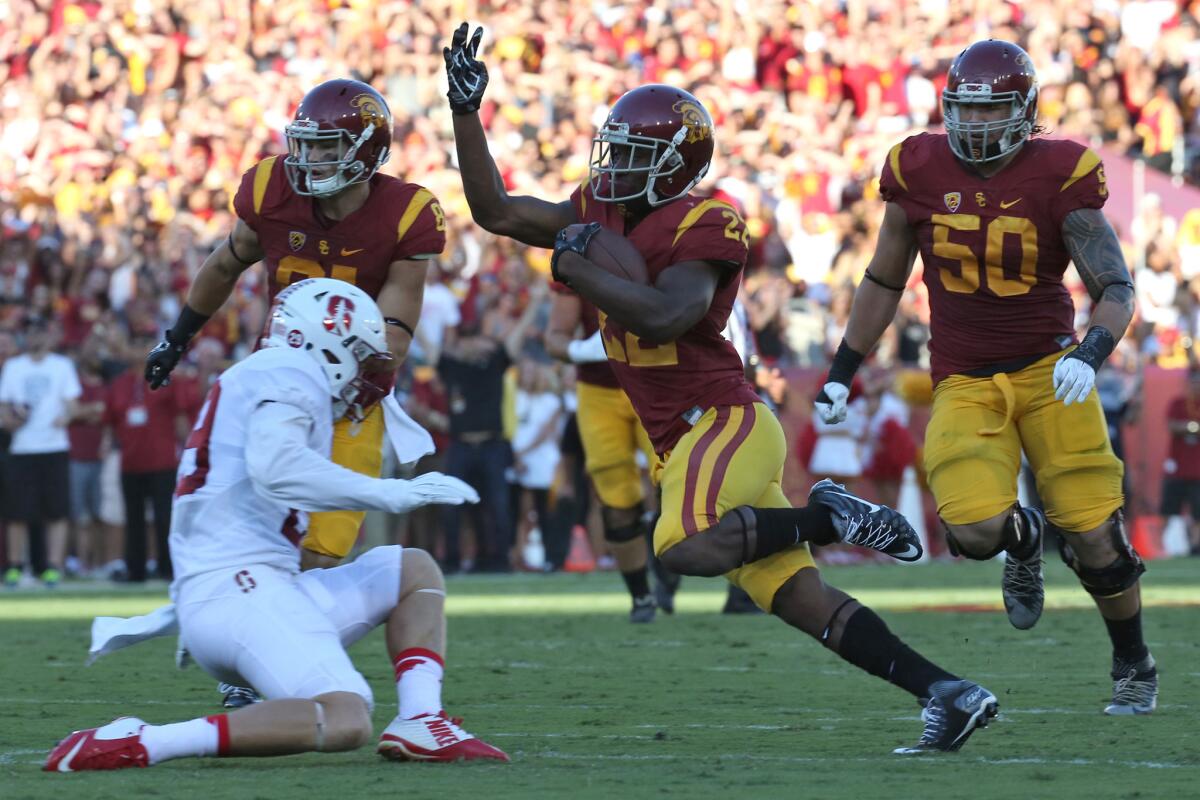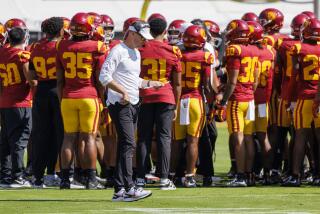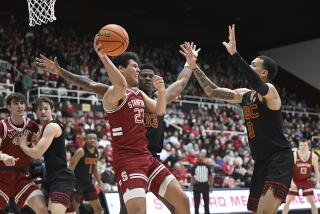How do USC and Stanford match up in Pac-12 championship?

USC’s Justin Davis cuts past Stanford’s Dallas Lloyd on Sept. 19.
Times deputy sports editor Mike Hiserman examines how the USC and Stanford football teams match up in advance of Saturday’s Pac-12 Conference championship game at Levi’s Stadium in Santa Clara:
::
Stanford run game vs. USC defense
Christian McCaffrey ran for 115 yards when the Cardinal defeated USC, 41-31, in September, but he was only part of the problem for the Trojans.
Remound Wright ran for three touchdowns — all one-yard runs — as Stanford largely controlled the line of scrimmage.
Wright has only 69 carries, and averages just 2.7 yards per run, but he’s scored 13 touchdowns. Operating behind a Cardinal line that averages more than 301 pounds, Wright is one reason why Stanford leads the Pac-12 in third-down conversions (50.9%) and fourth-down conversions (90.9%).
Stanford averages 222.0 yards rushing per game; USC gives up an average of 137.6.
USC’s defense has improved as the season progressed but has still been hurt by big rushing performances. C.J. Prosise ran for 143 yards and two touchdowns in 19 carries for Notre Dame, and Royce Freeman gained 147 yards in 20 carries for Oregon.
The Trojans must rely on some relatively inexperienced backup linebackers because of season-ending injuries to Cameron Smith and Lamar Dawson.
Smith, a freshman, has missed the last two games and still leads USC with 78 tackles. It’s up to Olajuwon Tucker, Uchenna Nwosu and Michael Hutchings to step up as fill-ins.
Edge: Stanford.
::
Stanford passing vs. USC secondary
Kevin Hogan, the Cardinal’s fifth-year senior quarterback, did a pretty good impersonation of former Stanford star Andrew Luck the last time these teams played.
Hogan completed 18 of 23 passes for 279 yards and two touchdowns, showing pinpoint accuracy and giving his tall, sure-handed corps of receivers chances to make plays.
USC’s young secondary responded well in coverage, but lost just about every jump ball.
One reason: Beyond Michael Rector, who is a rather ordinary 6 feet 1, Stanford receivers are 6-3 and 6-4, with tight ends who are 6-4 and 6-6.
Devon Cajuste, the 6-4 target, missed time with an illness but is a go-to wide out. And then there is leading receiver McCaffrey coming out of the backfield to snag 37 passes for 435 yards.
USC sacked Hogan three times the first time these teams played, and at 6-4, 225 pounds, he’s not nearly as elusive as Vernon Adams Jr., the Oregon quarterback whose ability to scramble proved lethal to the Trojans. But Hogan can be productive on quarterback draws — and when he’s flushed from the pocket and decides to tuck the ball and run. He had a 22-yard gain on a run against USC in September.
Edge: Stanford.
::
USC run game vs. Stanford defense
The conference championship and berth in the Rose Bowl — or, for Stanford, a place in the College Football Playoff — might swing on the winner of this matchup.
USC has turned into a physical running team under Coach Clay Helton, which is a bit of surprise since much of Helton’s background is working with quarterbacks.
The Trojans attack opponents with the trio of Tre Madden, Justin Davis and Ronald Jones II, who offer different strengths and looks. Madden gained 64 yards and Davis 46 the first time these teams met, which was before Jones, a freshman, became any kind of factor.
Jones is now USC’s leading rusher.
Davis has come on, too, and he was never more impressive than against UCLA last week, when he ran for 100 yards in the fourth quarter.
Stanford, its front ravaged by injuries, gave up 299 yards rushing last week against Notre Dame, which had two runners surpass 100 yards.
USC’s offensive line has also been plagued by injuries. The Trojans used their fourth-string center for a long stretch against UCLA and still kept the ball moving.
Edge: USC.
::
USC passing vs. Stanford secondary
Cody Kessler’s career passing percentage of 68.4% is a USC school record, and he was better than that the first time these teams met.
Kessler completed 25 of 32 passes for 272 yards and three touchdowns, including a 54-yard strike to JuJu Smith-Schuster.
If Stanford crowds the line of scrimmage in an effort to slow USC’s running game, Kessler will have to show he is willing and able to throw the ball down the field — a persistent knock against the fifth-year senior.
Smith-Schuster, who had eight catches for 154 yards against the Cardinal, is one of the nation’s best receivers. Steven Mitchell Jr., Darreus Rogers and Adoree’ Jackson provide USC with more playmakers as pass targets.
In September, Stanford sacked Kessler only once, and neither team forced a turnover.
Edge: USC.
::
Special teams
McCaffrey is averaging 252.92 yards per game in all-purpose yardage, leading any other player in major-college football by more than 50 yards per game.
His success on kickoff returns — 813 yards, a 31.3-yards average — is a big reason. He also has returned 12 punts, but for only 38 yards.
USC counters with Jackson, who is a factor on defense as a cornerback or safety, on offense as a receiver, and who returns both kickoffs and punts.
Jackson averages 23.1 yards per kickoff return and more than 10 yards per punt return, with two touchdowns.
Where Stanford has an advantage is in its kicking game.
Conrad Ukropina, a senior from Pasadena who played at Los Angeles Loyola High, drilled field goals of 42 and 46 yards in the first game against USC and beat Notre Dame last Saturday as time expired from 45 yards out.
He has made 15 of 17 field-goal attempts this season, with a long of 52.
USC’s Alex Wood, who recently returned from a concussion, has made 12 of 16 field goals with a long of 43.
Stanford’s Alex Robinson averages 43.2 yards per punt; USC’s Kris Albarado 41.2.
Edge: Stanford.
::
Coaching
Clay Helton will make his debut as USC’s coach — with all the permanency a five-year contract brings — in this game. He had a 5-2 record this season as the Trojans’ interim coach before he was promoted on Monday.
When Stanford defeated USC earlier this season, Steve Sarkisian was guiding the Trojans.
Emotion may be with Helton and USC, but Stanford still has hopes of making the four-team national playoff — and an experienced big-game coach at the controls.
David Shaw has the Cardinal playing for a Pac-12 title for the third time in four years. He is 2-0 in conference championship games, 2-2 in bowl games.
Edge: Stanford.
::
Final score
Stanford 40, USC 34 in overtime
More to Read
Go beyond the scoreboard
Get the latest on L.A.'s teams in the daily Sports Report newsletter.
You may occasionally receive promotional content from the Los Angeles Times.







